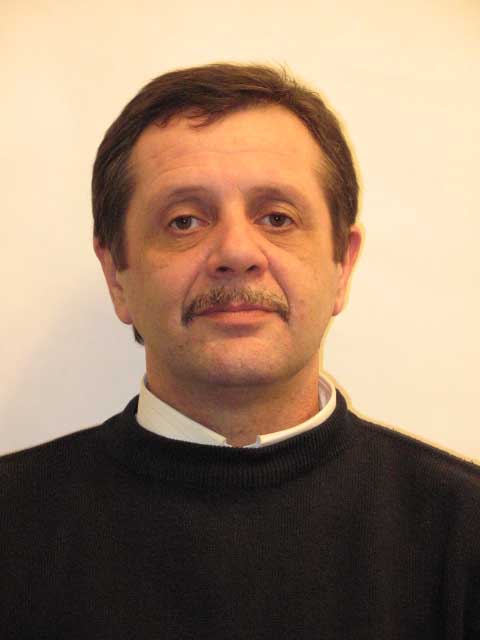 | Senior Researcher / PhD |
| Grigoriy A. Sheshin | |
| job: +38-057-341-08-17; local: 7-29 | |
| e-mail:sheshin[at]ilt.kharkov.ua | |
| | |
|
Graduated from Kharkov State University in 1972. Since 1985 he is with the Quantum fluids and Solids Department of ILTPE NAS Ukraine, defended a PhD Thesis in 1994. Study of the kinetics of the phase separation in liquid 3He-4He superfluid mixtures and dynamics of the new phase growth. Construction of the rapid nucleation line and identification of nucleation mechanisms in superfluid mixtures. Investigation of the superfluid turbulence in He II and superfluid mixtures. He is an author and co-author of over 90 publications.
Research activity - Superfluidity of 4He and 3He-4He solutions\Quantum turbulence,Thermodynamic properties and kinetic processes Recent publications:
2. V.A.Mikheev,E.Ya.Rudavskii, V.K.chagovets and G.A.Sheshin, Sov. J. Low Temp. Phys. 3. I.N.Adamenko, A.I.Chervanev, K.E.Nemchenko, V.A.Mikheev,E.Ya.Rudavskii, 4. J.Li, G.A.Sheshin, I.Roggatz and F.Pobell, , J. Low Temp. Phys., v.102, ½, 61(1996). 5. J.Nyeki, R.Ray, G.Sheshin, V.Maidanov, V.Mikheev, B.Cowan, and J.Saunders Low 6. V.K.Chagovets, E.Ya.Rudavskii, G.A.Sheshin, and I.A.Usherov-Marshak, J.Low Temp. 7. G.Sheshin, H.Abe, M.Nakazava,T.Satoh, J.Low Temp.Phys. 121,315-322 (2000) 8. E.Rudavskii,V.Chagovets, T.Kalko, I.Usherov-Marshak, G.Sheshin, J. of Molecular 9. E.Rudavskii, V.Chagovets, T.Kalko, A.Zadorozhko, G.A.Sheshin, Physica B, 329-333, 10..E.Rudavskii, V.Chagovets, T.Kalko, A.Zadorozhko, G.A.Sheshin, Physica B, 329-333, 11. E.Rudavskii, V.Chagovets, T.Kalko, A.Zadorozhko, G.A.Sheshin, J.Low Temp.Phys. 12. E.Rudavskii, V.Chagovets, T.Kalko, K.Neoneta A.Zadorozhko, G.A.Sheshin, 13. E.Ya.Rudavskii, V.K.Chagovets, T.V.Kalko, K.E.Nemchenko, A.A.Zadorozhko, 14. N.Dubrovinskaia, G.Eska, H.Braun, G.Sheshin Journal of Applied Physics, 99, 033903, 15. G.A.Sheshin, S.Sokolov , Journal of Molecular Liquids, 127, 153, (2006) Thermal 16. E.Rudavskii, V.Chagovets, T.Kalko, K.Nemchenko, A.Zadorozhko, G.A.Sheshin, 17. E.Rudavskii, V.Chagovets, T.Kalko, A.Zadorozhko, G.A.Sheshin, J.Low Temp.Phys. 18. E.Rudavskii, V.Chagovets, T.Kalko, A.Zadorozhko, G.A.Sheshin,J.Low Temp.Phys. 19. E.Rudavskii, V.Chagovets, T.Kalko, A.Zadorozhko, G.A.Sheshin, L.Skrbek, 2008 ФНТ, т34,11, 1111 - 1121 (2008) Features of transition to turbulence in superfluid 4Не at low temperatures The experimental research of the kinetic and dissipative processes in He II by means of vibrating piezoquartz resonator (tuning fork) immersed into liquid helium has been carried out. The electric response of a tuning fork near to its resonant frequency was measured at various exciting voltage in the field of temperatures from 0,1 K up to 4,2 K. The measured values of half-width resonant curves have allowed to determine viscosity of normal components He II in wide area of temperatures. The maximum of effective viscosity is found out at temperature 0,5 K which is connected with transition from a hydrodynamic mode to a ballistic mode in the phonon gas of He II. It is established, that at small speeds of fluctuations of a tuning fork linear dependence of speed of fluctuation on exciting force that corresponds to laminar current of a liquid in a boundary layer near the vibrating surface is observed. Thus, the basic dissipative process is connected with viscosity of normal component. Thickness of a boundary layer near the surface of vibrating tuning fork is estimated. At the high speeds fluctuation of the tuning fork the breaks on dependence of the electric response on the exciting voltage, testifying about transition to nonlinear character of flow have been found out. At low temperatures this mode was accompanied by occurrence of flat sites on resonant curves near to a maximum. It is possible to explain such behavior by transition from laminar to turbulent flow of the liquid, that also it is accompanied by occurrence additional dissipation, connected with a birth of the quantized vortices. Critical speed of transition to the turbulent mode which temperature dependence will qualitatively be coordinated with the measurements received earlier with vibrating bodies of other form is determined. | |
 |
Quantum Fluids and Solids Department | Tuesday, 08.07.2025, 10:10 |
 |
 |
 |
Welcome Гость | RSS |  |
| |||||||||||||||||||||||||||||||||||||||||||||||||||||||||||||||||||||




